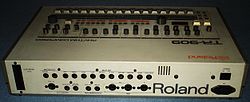|
Roland TR-909
The Roland TR-909 Rhythm Composer, commonly known as the 909, is a drum machine introduced by Roland Corporation in 1983, succeeding the TR-808. It was the first Roland drum machine to use samples for some sounds, and the first with MIDI functionality, allowing it to synchronize with other devices. Though a commercial failure, it influenced the development of electronic dance music genres such as techno, house and acid house. DevelopmentThe TR-909 succeeded the previous Roland drum machine, the TR-808.[1] It was designed by Tadao Kikumoto, who also designed the Roland TB-303 synthesizer.[2] The chief Roland engineer, Makoto Muroi, credited the software design to Atsushi Hoshiai and the analog and pulse-code modulation voice circuits to "Mr Ou".[3][4] The 909 was the first Roland drum machine to use samples, for its crash, ride and hi-hat sounds.[5] Hoshiai sampled his own kit for the cymbals, using a mismatched pair of Paiste and Zildjian hi-hat cymbals.[4] He sampled them in 6-bit and edited the waveform on a computer with a CP/M-80 operating system.[4] Other sounds are generated with analog synthesis.[5] According to a Roland representative, the engineers felt that samples had some disadvantages and so opted for a combination of sampled and analog sounds.[6] Sounds and featuresWhereas the 808 is known for its "boomy" bass, the 909 sounds aggressive and "punchy".[1][7] It has 11 percussion voices and offers sounds for bass drum, snare, toms, rimshot, clap, crash cymbal, ride cymbal and hi-hat (open and closed).[8] It omits the clave, cowbell, maracas, and conga sounds from the 808.[8] The bass has controls for attack and decay.[8] The snare has controls for tone and "snappy", which adjusts the amount of the snare wire sound.[8] As the clap and snare are generated via the same noise source, they produce a phasing effect when played together.[9]  The 909 features a sequencer that can chain up to 96 patterns into songs of up to 896 measures, and offers controls including shuffle and flam.[5] Users can add accents to beats.[3] The 909 was the first Roland drum machine to use MIDI,[3] allowing it to synchronize with other MIDI devices,[5] or to allow sounds to be triggered by an external MIDI controller for wider dynamic range.[3] Older Roland machines can be synchronized via its DIN sync port.[3] ReleaseThe 909 was released in 1983[5] and retailed for $1,195 USD, equivalent to $3,656 in 2023.[5] It attracted interest in the industry as the first Roland instrument to use digital sounds.[10] In its review, Electronics & Music Maker found the 909 easier to use than the 808 and felt it offered the best analog drum sounds on the market. It concluded that it offered a good combination of analog and sampled sounds and that the addition of MIDI brought the 909 "as up to date as it needs to be".[8] One Two Testing found the 909 "gloriously easy to use", but felt it was overpriced and "still sounds like a drum machine, instead of a machine playing drums ... It lacks the authenticity of real sounds for studio work."[10] The 909 was a commercial failure, as users preferred the more realistic sampled sounds of competing products such as the LinnDrum.[3] Roland ceased production after one year,[3] having built 10,000 units.[11] Roland changed elements of the 909 in later revisions, correcting problems and adjusting sounds. Some users modify their machines to match sounds from earlier revisions.[9] LegacyWhereas the TR-808 was important in the development of hip hop, the 909, alongside the 303 synthesizer, influenced dance music such as techno, house and acid.[7][12] According to Gordon Reid of Sound on Sound, "Like the TR-808 before it, nobody could have predicted the reverence in which the TR-909 would eventually come to be held."[5]  The first known commercial use of a 909 is on the EP Remission by the industrial band Skinny Puppy, released months after the 909.[5][13] In the late 1980s, the 909 was popularized by Chicago house and Detroit techno producers such as Derrick May, Frankie Knuckles and Jeff Mills, who bought second-hand units.[1] DJ Sneak said that "every Chicago producer was using the 909".[13] Mixmag described Mills as the "master" of the 909.[14] Mills said its design made it possible to "play" the 909 rather than just program it, using the tuning controls to imitate the feel of a live drummer.[14] The 909 was used on hip-hop records by acts including Boogie Down Productions, Ultramagnetic MCs, Jazzy Jeff and the Fresh Prince and Public Enemy.[13] Kurtis Mantronik used the 909 on records by his hip hop group Mantronix and records he produced for other artists, such as Back to the Old School (1986) by Just-Ice.[13] In the early 1990s, the Japanese composer Yuzo Koshiro incorporated samples of the 909 in his soundtracks for the Streets of Rage games.[15] That decade, the 909 was adopted by pop musicians such as Madonna and Pet Shop Boys,[13] and by rock and alternative musicians. Mark Bell used it to create "militaristic" percussion for Björk's 1997 song "Hunter",[16][17] and Radiohead used it on "Videotape", from their 2007 album In Rainbows.[18] Electronic artists such as Kirk Degiorgio and Cristian Vogel created sample libraries by recording their friends' machines.[14] The 909 was succeeded in 1984 by the TR-707, which uses samples for all its sounds.[3] In 2017, Roland released the TR-09, a smaller version of the 909 with additional features.[9] References
Further reading
|
||||||||||||||||||||||||||||||||||||||||
